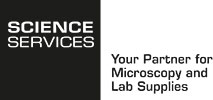Removal Of Lead Citrate and Uranyl Acetate Precipitates on L.R. White Sections
Pamela Neill Center of Biotechnology,Baylor College of Medicine, The Woodlands, TX
Introduction
L.R. White (EMS cat. #14380) is a hydrophilic embedding agent which allows aqueous solutions to easily pass through thin sections. Conventional methods for eliminating uranyl acetate precipitates (Hayat, 1986) suggest treating sections with 0.5% oxylic acid for 12 sec., 10% acetic acid for 1 min., or 2% aqueous (or ethanolic) solution (EMS cat. #22400) of uranyl acetate for 1 min. Lead precipitates are eliminated by treatment with 2% aqueous uranyl acetate 2-8 min. at room temperature or 10% aqueous acetic acid for 1-5 min. Unfortunately, these methods may destroy the continuity of L.R. White sections.
Our lab has modified the conventional methods of Hayat to avoid or eliminate stain precipitates on L.R. White sections before and after they have been under the electron beam, while keeping the section intact.
Materials and Discussion
Our first objective is to prevent stain precipitates from forming during the staining process. Warm distilled water is used for the final rinse of the grid to avoid uranyl acetate precipitate. A 10ml beaker of distilled water is set into the curing oven (50°C) during the staining procedure and taken out for use prior to the rinse step. To avoid lead precipitate during the staining process, add one sodium hydroxide pellet in 10ml distilled water. Stain with lead, dip once in the solution, then wash with distilled water.
We have successfully removed uranyl acetate and lead salts from L.R. White embedded sections by dipping the grid in 0.25% filtered oxalic acid. Retain the section 3-4 times longer than the original stain time. This method has worked in our laboratory on sections that have not been under the electron beam for prolonged exposure (30 min. or longer).
Reference: Hayat, M.A. (1986.) Basic Techniques for Transmission Electron Microscopy. pg. 225



